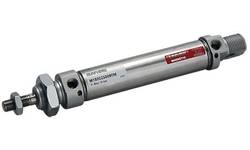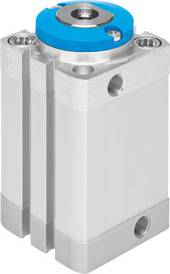Guide
This text is machine translated.
Useful information about pneumatic cylinders and pneumatic drives
Pneumatic systems are part of many industrial plants. We explain the design and function of pneumatic cylinders, what you should pay attention to when buying them and what advantages a pneumatic drive offers.
Application areas for pneumatic systems
How does pneumatics work?
Function and design of pneumatic cylinders
What was the point of ich when purchasing pneumatic cylinders?
Our practical tip: Observe test intervals
FAQ – frequently asked questions about pneumatic cylinders
Application areas for pneumatic systems
Pneumatics are used in almost all areas of industry. This includes both the food and automotive industries . Bottling plants or painting lines would be unthinkable without the use of compressed air in their present form. Pneumatic systems are also firmly established in medicine, mining, space technology and many other industries and industries.

How does pneumatics work?
The term pneumatics derives from the ancient Greek word pneuma, was meant as much as "wind". In pneumatic drives, air, more specifically compressed air, is used to perform mechanical work. But how exactly does it work? In order to be able to use a pneumatic cylinder, for example, compressed air must be generated in the first step. This is usually done by a compressor (compressor) which draws in ambient air and compresses it so that finally there is between 6 and 40 bar pressure in the compressed air system.
The ambient air is often contaminated by particles such as oil, dust or pollen . Before it is fed to a pneumatic drive, it is important that the compressed air is removed from these impurities. Failure to do so may result in damage to the machines. The cleaned air is routed through a network of pipes to the individual machines. A compressed air accumulator integrated into the system serves as a buffer and keeps the pressure in the distribution system constant . This has the advantage that the compressors only have to run when the pressure in the line network decreases again. Now compressed air can drive, for example, a compressed air cylinder in a factory or the impact driver in a car workshop.
Figure: Compressed air system
1. Compressor
2. Pressure gauge
3. Thermometer
4. Relief valve
5. Stopcock
6. Compressed air line with 1 - 2% slope
7. Compressed air distribution
8. Cache
9. Maintenance unit
10. Condensate collector 11
. Condensate drain valves
Function and design of pneumatic cylinders
In pneumatics, there are different drives, such as compressed air motors or cylinders . The design of a cylinder is relatively simple: Next to the cylinder pipe, a compressed air cylinder consists of two covers, which close the pipe to both sides, as well as a piston rod with drive piston. The pneumatic cylinders can be divided according to the design, movement or function. erfolgen. Various designs include cylinders with piston rod, rotary cylinder, round cylinder, profile cylinder or diaphragm cylinder. Linear or rotating sequences are possible as executable movements, while the function can be distinguished in single-acting and double-acting.
A single-acting air cylinder has a single compressed air connection . When air is directed into the cylinder, the piston moves out of the cylinder pipe. When the air escapes again, the piston rod returns to its initial position. Such single-acting cylinders therefore only develop force in one direction. On the other hand, two compressed air connections are available for a double-acting cylinder. Depending on which of the two ports is supplied with air, the piston moves in either direction. Since a cylinder acting in this way transmits power to both sides, it is called double-acting air cylinders.
Illustration of the air cylinder
1. Ground dec
kel
2. Seal (O-ring)
3. Piston seal (O-ring)
4. Seal (O-ring)
5. Sealing ring
6. Guide ring.
7. Scraper
8. Bearing cover
9. Air connection
10. Piston rod
11. Piston
12. Air connection
What was the point of ich when purchasing pneumatic cylinders?

ISO stainless steel cylinders are a good choice for environments that require high levels of hygiene. Make sure that the stroke length of cylinders and compact cylinders is sufficiently dimensioned for the intended use. There are also special designs for air cylinders for many applications: For example, special compact cylinders are available for use in confined spaces. In addition, there are series which are equipped with a continuous piston rod or also cylinder without piston rod.
In our online shop we offer numerous products from the field of pneumatics, which find solutions for almost every need. In addition to a wide selection of piston rod, multi-position, clamping and stopper cylinders, our extensive range also includes accessories and spare parts suitable for the series. In addition, our shop offers various drives such as bellows, diaphragm and swivel drives as well as drives with guides. In addition, we have round tables, shock absorbers and a large range of accessories for grippers.
Our practical tip: Observe test intervals
Technical systems that work with compressed air are subject to regular inspection intervals from one year onwards starting from certain operating values with all safety-relevant components. Do not use devices or plant components that have not been tested or whose test intervals have been exceeded. In Germany, the maximum limit for periodic tests is 5 years for internal testing and 10 years for strength testing . The basis for this is the Ordinance on Industrial Safety and Health (BetrSichV) for operators of pressure vessels requiring monitoring.
FAQ – frequently asked questions about pneumatic cylinders
What are the advantages of pneumatics?
Pneumatic drives are particularly characterized by their robustness. They are largely resistant to various environmental influences and vibrations. Since compressed air is used only in pneumatics, the technology is also very clean and can easily be used in sensitive areas such as the food industry to drive and control plants. In contrast to a hydraulic cylinder, a leak in the compressed air line only escapes air, so no contamination can occur. A drive that uses compressed air usually does not cause damage if overloaded. The large amount of waste heat generated by air compression can be used for heating. And last but not least, drives that use compressed air are comparatively cheap in terms of purchasing and maintenance compared to hydraulics.
What was the end position damping for a pneumatic cylinder?
A so-called end position damping is used when a cylinder has to move large masses. As the piston of an air cylinder retracts again, the speed of the piston is slowed down by a damping piston in the last part of the way.